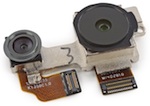In this edition of Embedded Vision Insights:
- Vision Processing on Mobile Devices
- Developing Low-Cost, Low-Power, Small Vision Systems
- Augmented Reality: A Compelling Opportunity
- Embedded Vision in the News
| LETTER FROM THE EDITOR |
|
There’s been quite a burst of interesting news lately about vision technology being used in mobile devices, a topic which has also been regularly covered in past presentations and articles hosted on the Alliance website. A month back, for example, we discussed the rumored depth-sensing capabilities of the latest "M8" variant of HTC's One smartphone, capabilities that were confirmed at the handset's unveiling a short time later, complete with a product teardown. We also covered Google's revolutionary Project Tango handset, which showcases robust 3D mapping facilities. Project Tango has recently also been disassembled and analyzed, found to contain an infrared projector and multiple embedded vision processors. And just a few days ago, the first photos of the claimed coming-soon Amazon-branded smartphone have surfaced, along with some intriguing claimed embedded resources: a beefy Qualcomm application processor, front and rear conventional cameras, and four front-mounted infrared sensors supposedly for head- and eye-tracking purposes. These and other trendsetting embedded vision capabilities, not just for mobile electronics devices but a plethora of systems, will be on display at the Embedded Vision Summit West in just over a month. Taking place May 29th at the Santa Clara (California) Convention Center, its comprehensive program encompasses two tracks' worth of sixteen total technical presentations, hour-long keynotes from both Facebook and Google, and technology demonstrations from nearly two dozen Alliance member companies. Two in-depth technical workshops are additionally offered the prior day. And the Embedded Vision Summit West is also co-located with the Augmented World Expo, with special discounts available for Summit attendees. Last year's Embedded Vision Summit sold out, so I encourage you to register today and not further delay! And while you're up on the Alliance website, make sure you check out all the other great new content published there in recent weeks. Thanks as always for your support of the Embedded Vision Alliance, and for your interest in and contributions to embedded vision technologies, products and applications. I welcome your emailed suggestions on what the Alliance can do better, as well as what else the Alliance can do, to better service your needs. Brian Dipert |
| FEATURED VIDEOS |
|
Embedded Vision Summit Technical Presentation: "Developing Low-Cost, Low-Power, Small Vision Systems," Simon Morris, CogniVue
January 2014 Consumer Electronics Show Product Demonstration: GEO Semiconductor
|
| FEATURED ARTICLES |
|
Augmented Reality: A Compelling Mobile Embedded Vision Opportunity
How GPUs Help Computers Understand What They’re Seeing
|
| FEATURED NEWS |
|
The Rise of (Embedded) Vision Systems: Using Image Analysis Intelligence to Solve Robotic Design Problems Another Day, Another Vision-Enhanced Handset: Amazon's Rumored Entrant is a Nifty 3D-Effects Interface Gadget TI Broadens Offerings for Advanced Driver Assistance Systems with New Vision Software Development Kit, Embedded Vision Engine and DSP Libraries Peering Inside an Advanced Smartphone: Google's Project Tango Implements Technology Already Well-Known videantis Wins Red Herring Award For Its Vision and Video Processor IP Technology
|







